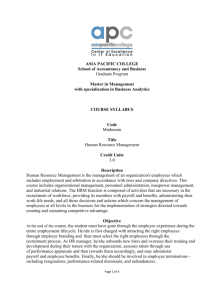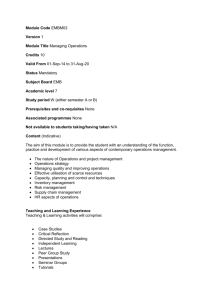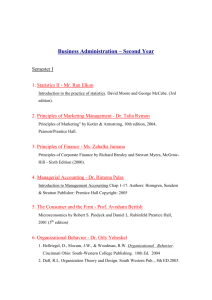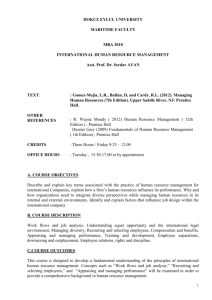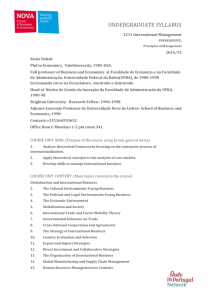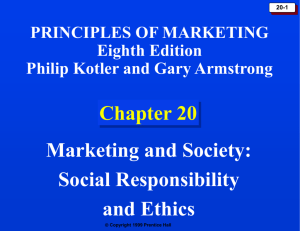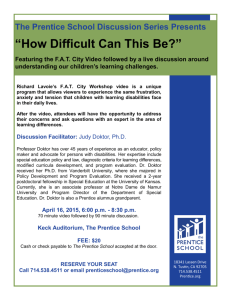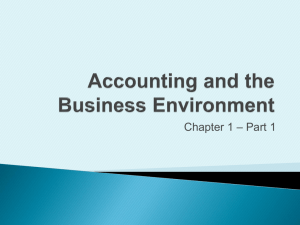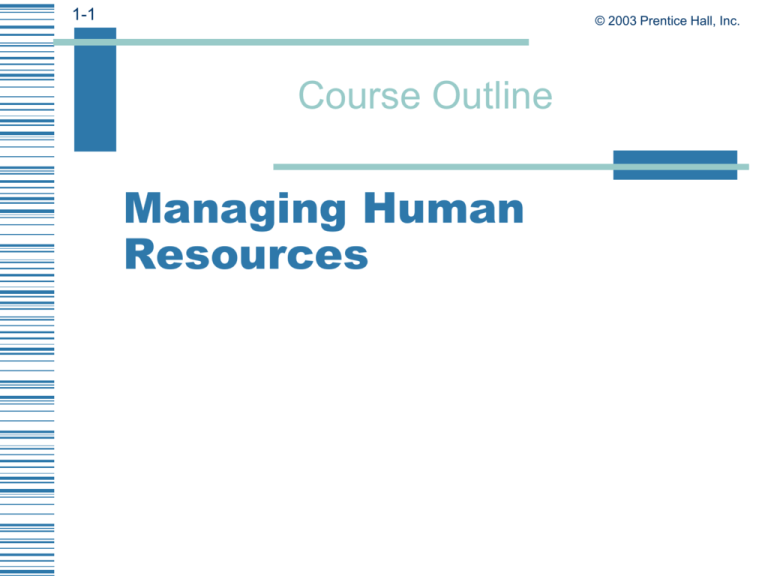
1-1
© 2003 Prentice Hall, Inc.
Course Outline
Managing Human
Resources
1-2
© 2003 Prentice Hall, Inc.
Course Outline
References
Dessler, Gary. Human Resource
Management, 10th ed. Pearson
Prentice Hall: 2005
1-3
© 2003 Prentice Hall, Inc.
Outline of Introduction
I. Introduction
II. What is Management?
III. What is Human Capital and Human
Resource Management?
IV. How does HRM relate to the
functions of management?
V. What is the HRM process?
1-4
I.
© 2003 Prentice Hall, Inc.
The Manager’s Human Resource
Management Jobs
Why is HR Management Important to All
Managers?
Line and Staff Aspects of HRM
Cooperative Line and Staff HR Management: An
Example
1-5
© 2003 Prentice Hall, Inc.
Outline of Chapter 1
II.
Strategic Planning and Strategic
Trends
III. HR’s Strategic Role
HR’s Evolving Role
Strategic Human Resource Management
HR’s Role as a Strategic Partner
1-6
© 2003 Prentice Hall, Inc.
Management
Management
the process of coordinating work activities so
that they are completed efficiently and
effectively with and through other people
elements of definition
Process - represents ongoing functions or primary
activities engaged in by managers
Coordinating - distinguishes a managerial position
from a non-managerial one
1-7
© 2003 Prentice Hall, Inc.
Organization and Manager
An organization consists of people with
formally assigned roles who work
together to achieve the organization’s
goals.
Manager is a person responsible for
accomplishing the organization’s goals
and who does so by managing the efforts
of the organization’s people.
1-8
© 2003 Prentice Hall, Inc.
Management
Efficiency (Means)
Effectiveness (Ends)
Resource
Usage
Goal
Attainment
Low Waste
High Attainment
Management Strives For:
Low resource waste (high efficiency)
High goal attainment (high effectiveness)
1-9
© 2003 Prentice Hall, Inc.
The Management Process
Planning
Organizing
Staffing
Leading
Controlling
1-10
© 2003 Prentice Hall, Inc.
Management Process
Planning
Establishing Goals and standards
Developing Rules and procedures
Developing Plans and forecasting.
Organizing
Giving each subordinate a specific Tasks
Establishing Departments
Delegating authority to subordinates
Establishing channels of Authority and
communication
Coordinating the work of subordinates
1-11
© 2003 Prentice Hall, Inc.
Management Process
Staffing
Determining what type of people should be
Hiring
Recruiting employees
Selecting employees
Setting Performance standards
Compensating employees
Evaluating performance
Counseling employees
Training and developing employees
1-12
© 2003 Prentice Hall, Inc.
Management Process
Leading
Getting the job done
Maintaining Morale
Motivating subordinates
Controlling
Setting standards such as quotas,quality standards
Comparing actual performance to standards
Taking Corrective action
1-13
© 2003 Prentice Hall, Inc.
Management Functions
Planning - defining goals, establishing strategies for
achieving those goals, and developing plans to integrate and
coordinate activities
Organizing - determining what tasks are to be done, who is
to do them, how the tasks are to be grouped, who reports to
whom, and where decisions are made
Staffing - HRM
Leading - directing and motivating all involved parties and
dealing with employee behavior issues
Controlling - monitoring activities to ensure that they are
going as planned
1-14
© 2003 Prentice Hall, Inc.
Human Resource
Management
Planning - defining goals, establishing strategies for
achieving those goals, and developing plans to integrate and
coordinate activities
Organizing - determining what tasks are to be done, who is
to do them, how the tasks are to be grouped, who reports to
whom, , where decisions are made and who is decision
taker
Staffing - HRM
Leading - directing and motivating all involved parties and
dealing with employee behavior issues
Controlling - monitoring activities to ensure that they are
going as planned
1-15
© 2003 Prentice Hall, Inc.
HRM Function
Human Resource Management is the process
of acquiring, training, appraising, and
compensating employees and attending to
their labor relations, health and safety, and
fairness concerns.
1-16
© 2003 Prentice Hall, Inc.
HRM People Functions
Include:
Conducting Job
analyses
Planning Labor needs
Recruiting candidates
Select candidates
Orient and training
new employees
Wages and salaries
Incentives and benefits
Appraising Performance
Communicating
Train and develop
managers
Employee commitment
Equal opportunity
Health and safety
Grievances/labor
relations
Knowing employment
law
1-17
© 2003 Prentice Hall, Inc.
HRM is Important to all Managers.
Don’t Let These Happen to You!
The wrong person
High turnover
Poor results
Useless interviews
Company taken to Court for discriminatory
actions
Safety citations
Salaries appear unfair
Poor training
Unfair labor practices
1-18
© 2003 Prentice Hall, Inc.
HRM – It’s All About Results
“For many years it has been said that capital is
the bottleneck for a developing industry. I don’t
think this any longer holds true. I think it’s the
work force and a company’s inability to recruit
and maintain a good work force that does
constitute the bottleneck….” F. K. Foulkes
1-19
© 2003 Prentice Hall, Inc.
Human Resource
Management Process
1-20
© 2003 Prentice Hall, Inc.
Line and Staff Aspects of
HRM
Authority
Right to Make decisions
Directing work
Giving orders
Line Managers
Accomplishing goals by issuing orders
Staff Managers
Assisting and advising line managers
1-21
© 2003 Prentice Hall, Inc.
Line Manager’s HRM Jobs
The right person
Orientation
Training
Performance
Creativity
Working
relationships
Policies and
procedures
Labor costs
Development
Morale
Protecting
1-22
HR Department
Organizational
Chart
© 2003 Prentice Hall, Inc.
1-23
© 2003 Prentice Hall, Inc.
Line & Staff HR
Example
Exactly which HR management activities are carried
out by line managers & by staff managers?
There is no single division of responsibility applied to
all organizations
Example in the recruiting & hiring of employees:
Usually the line manager specifies the qualifications needed to
fill specific positions.
Then the HR manager develops sources of qualified
candidates, conduct initial screening (tests) and send those
filtered to line manager
Line manager conducts the final technical screening tests and
selects the one to hire or requests new applicants
1-24
© 2003 Prentice Hall, Inc.
Changing Environment of
HR Management
Globalization
Technological Advances
Exporting Jobs
The Nature of Work
Workforce Diversity
1-25
© 2003 Prentice Hall, Inc.
Globalization
80
70
60
50
% fortune 500 with a
global presence
40
30
20
10
0
1920
1950
1970
2000
1-26
© 2003 Prentice Hall, Inc.
Globalization
Globalization is the tendency of firms to extend their
sales,ownership and manufacturing to new markets
abroad.
Eg : Toyota manufactures camry in kentucky and Dell
produces PC s in china
Companies expand abroad for several reasons – sales
expansion,seek new foreign products and services to
sell.
Infosys,tcs,tata steel,mittal steel,ge,american exp,dell
,google ,indian firms affected by recession.
1-27
© 2003 Prentice Hall, Inc.
Companies Expansion Sales Expansion
Google expanded its china presence by
initiating its Google china instant
messaging service.
Walmart is opening stores in south
America.
Dell is aggressively building plants in
china and selling there knowing the
future market
1-28
© 2003 Prentice Hall, Inc.
New foreign products and
services
Apparel manufacturers design and cut
fabrics in Miami and then have actual
products assembled in Central America
where the labour cost is low.
Prospects of finding new partners abroad
– IBM sold its PC division to Chinese firm
Lenovo
1-29
© 2003 Prentice Hall, Inc.
Globalization
More globalization means more competition
and more competition means more pressure to
be world class - to lower costs to make
employees more productive and to do things
better and less expensively.
The bottom line is that the growing integration
of the world class economy into a single huge
market place is increasing the intensity of
competition in a wide range of manufacturing
and service industries.
1-30
© 2003 Prentice Hall, Inc.
Advantages and
Disadvantages of
Globalization
For consumers it is having more variety of
products at a cheaper prices
For business owners it is having many new
customers and more competitors.
For employees it poses a threat of job
offshoring.
US Imports and exports :
47 billion $ 1960 * 562billion $ -1980
4.3 trillion $ 2008
1-31
© 2003 Prentice Hall, Inc.
Technological Advances and the
Nature of Work
Technology mandates and enables
companies to be more competitive Carrier
High Tech Jobs - Knowledge
intensive jobs in industries such as
aerospace, computers,
telecommunications, and
biotechnology are replacing factory
jobs in steel, auto, rubber and
textiles
Eg : zaara ,lockheed,indian railways
1-32
© 2003 Prentice Hall, Inc.
Service Jobs
Two thirds of US force is employed in
producing and delivering services not
products.
Reason for service oriented industry –
more manufacturing jobs are shifting to
low wage countries.
Service jobs have also shifted to
countries like India and Philippines where
skilled labour are available at low cost.
1-33
© 2003 Prentice Hall, Inc.
Exporting Jobs
Competitive pressures and the search
for greater efficiencies are prompting
more employers to export jobs abroad.
Technology has facilitated the move of
jobs offshore.
Call centers in India allow for: 24 hours,
cheaper labor, standardized, efficient
service
1-34
© 2003 Prentice Hall, Inc.
Knowledge Work and
Human Capital
Human Capital refers to knowledge education,
training,skills and expertise of a firm’s workers.
“ the center of gravity in employment is moving fast
from manual and clerical workers to knowledge
workers”
HR managers listed “critical thinking/problem solving”
and “info tech application” as the two applied skills in
importance over next few years.
HRM skills – recruiting,screening,training and paying
employees – more important to employers
Bank example
1-35
© 2003 Prentice Hall, Inc.
Demographic Trends
In spite of the recession and job losses
workforce demographic trends are
making finding and hiring good
employees more of a challenge around
the world.
Skill shortage is identified as a main
hurdle in achieving demographic dividend
from its young growing population.
1-36
© 2003 Prentice Hall, Inc.
The Workforce Itself is
Diverse
Asian
Black
Hispanic
Men
Women
US Department of Labor website
1-37
© 2003 Prentice Hall, Inc.
The Workforce Itself is
Diverse
More women, minorities, and older employees
are joining the workforce
Workforce diversification offers increasing
opportunities including: a wide range of skills
and talents (languages), different points of
view, different life experiences
Old perspective was melting pot approach.
Now, there is a celebration of differences
The challenge lies in the widening range of
employee needs (benefits range is much
wider so may be flexi-time would be adopted)
1-38
© 2003 Prentice Hall, Inc.
Generation Y
Young workers are more family oriented or dual
balanced.
Old workers are work centric.
Todays “millennial” or “generation Y” employees will
bring challenges and strength.
The most high maintenance workforce in the history of
world .
Refer to them as “most praised generation”.
As the first generation to cope up with IT.
1-39
© 2003 Prentice Hall, Inc.
Economic challenges and
Trends
In 2001 – 2007 – Gross National Product
boomed .Home prices leaped upto 20%
and unemployment remained docile
(4.7%)
2007-2008 – all these measures
seemingly fell off the cliff.Home prices
dropped to 20% and unemployment rose
to 8%
1-40
© 2003 Prentice Hall, Inc.
Consequences of these basic
trends
Global expansion
Technology
Strengths and
Weaknesses
Improved competition
Uncertainty,
Turbulence,
Rapid
Change,
Changing
power
bases
Companies
must be
Fast,
Responsive,
and
Costeffective
1-41
© 2003 Prentice Hall, Inc.
Important Trends In human
Resource Management
The New Human Resource Managers
Strategic Human Resource Management
Evidence Based Human Resource
Management
Managing ethics.
1-42
© 2003 Prentice Hall, Inc.
New Human Resource
Managers
They are more involved in big picture
issue.
Example : Wiscosin based Signicast
corp’s president Terry Lutz and his board
decided to build a new computerized
plant.New automation of plant demanded
new employees.HRM dept evolved to
select train and organize tech friendly
employees
1-43
© 2003 Prentice Hall, Inc.
New HRM
New ways to provide transactional
services
They outsource more of their services to
outside vendors.
They use latest technologies (internet
based websites) to enable employees to
self administer benefit plans.
Employees of Dell set up call centers to
solve HR related enquiries
1-44
© 2003 Prentice Hall, Inc.
New HRM
They have new proficiencies.
They require broader business
knowledge
HR managers need to be familiar with
strategic planning,marketing,finance and
production.
1-45
© 2003 Prentice Hall, Inc.
HR’s evolving role
Protector
and
Screener
Change Agent
Strategic Partner
1-46
© 2003 Prentice Hall, Inc.
HR’s evolving role as strategic
partner
Corporate
Corporatestrategy
strategy
HR
HRoperations
operations
Corporate
Corporatestrategy
strategy
HR
HRprograms
programs
Corporate strategy
FedEx
HR programs
1-47
© 2003 Prentice Hall, Inc.
The New HR Manager
New Proficiencies
HR proficiencies
Business proficiencies
Leadership proficiencies
Learning proficiencies
The need to know the employment laws
HR and technology
Technology improves HR functioning in 4 main
ways: self-service, call centers, productivity
improvement, and outsourcing.
1-48
© 2003 Prentice Hall, Inc.
Strategic Management
The set of managerial decisions
and actions that determines
the long-run performance
of an organization.
1-49
© 2003 Prentice Hall, Inc.
Strategic Human Resource
Management
HR strategies refers to the specific human resource
management courses of action the company pursues
to achieve its aims.
Strategic Human Resource Management means
formulating and executing HR systems (HR policies &
activities) that produce the employee competencies
and behaviors the company needs to achieve its
strategic aims
Instructor presentation questions: docwin@tampabay.rr.com
1-50
© 2003 Prentice Hall, Inc.
HR’s Strategic Roles
Today’s HR managers fulfill two basic strategic
planning roles: strategy execution and strategy
formulation
Strategy execution (traditional role): top management
formulates the company’s corporate strategies and HR
develops systems that support or align with the
corporate strategy.
Strategy formulation (today’s role): a partner in the
setting of the corporate strategy and its execution.
Instructor presentation questions: docwin@tampabay.rr.com
1-51
© 2003 Prentice Hall, Inc.
HR Scorecard Approach
HR Scorecard: Measures the HR
function’s effectiveness and efficiency in
producing employee behaviors needed
to achieve the company’s strategic goals.
Instructor presentation questions: docwin@tampabay.rr.com
1-52
© 2003 Prentice Hall, Inc.
Steps in the HR Scorecard
Approach
Step 1: Define the
Business Strategy
Step 2: Outline the
company’s value chain
Step 3: Identify the
Strategically Required
Organizational Outcome
Step 4: Identify the Required Workforce
Competencies & Behaviors
Step 5: Identify Relevant HR System
Policies & Activities
Step 6: Design the HR Scorecard
Measurement System
Step 7: Periodically Evaluate the
Measurement System
1-53
© 2003 Prentice Hall, Inc.
The Value Chain Approach
© 2003 Prentice Hall, Inc.
1-54
HR Scorecard Approach
Example (Paris Hotel)
1. The Strategy: “The Hotel will use superior guest
services to differentiate its properties, and to thereby
increase the length of stays and the return rate of guests,
and thus boost revenues and profitability”
2. The Value Chain: Service industry, where the product is
a satisfied customer. Value chain activities: inbound
logistics, operational activities, outbound activities,
service activities, support activities.
Instructor presentation questions: docwin@tampabay.rr.com
© 2003 Prentice Hall, Inc.
1-55
HR Scorecard Approach
Example (Paris Hotel)
3. Strategically Required Organizational Outcomes:
Each step in the chain presents opportunities for
improving guest services. Produce fewer complaints,
more written complaints, more guest returns, longer
stays, higher expenditure per visit.
4. Relevant Workforce Competencies: motivated, high
moral employees
5. Strategic HR System Policies and Activities: Fair and
strict HR practices will produce higher moral and thus
better service
Instructor presentation questions: docwin@tampabay.rr.com
© 2003 Prentice Hall, Inc.
1-56
HR Scorecard Approach
Example (Paris Hotel)
6. The HR Scorecard (cause and effect relation):
•
Improved disciplinary procedures – how many
grievances per month - means
•
Improved moral – seminar attitude surveys - leads to
•
High quality service – customer complaints per month
Instructor presentation questions: docwin@tampabay.rr.com
1-57
© 2003 Prentice Hall, Inc.
Thank You

